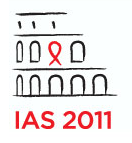Tenofovir/FTC vs tenofovir as daily oral PrEP: preliminary results from Partners PrEP
1 August 2011. Related: Conference reports, Antiretrovirals, HIV prevention and transmission, IAS 6th Rome 2011.
 Simon Collins, HIV i-Base
Simon Collins, HIV i-Base
The final presentation in the Treatment is Prevention session was a summary of the first results from the Partners PrEP study that randomised the HIV-negative partner in 4758 HIV serodifferent heterosexual couples to daily tenofovir (TDF) vs tenofovir/FTC (TVD) vs placebo in a 1:1:1 ratio. [1]
The results presented were based on a DSMB analysis a week before the conference that recommended unblinding the placebo arm and switching those participants to active drugs. This was based on significantly reduced risks of transmission in both the active arms and was 18 months earlier than the planned study endpoint.
This study was run in nine sites in Kenya and Uganda with all participants receiving intensive healthcare and adherence counselling including free condoms. The negative partners were seen monthly for counselling with HIV and pregnancy testing and the positive partners were monitored for their HIV care every three months.
Baseline demographics were similar across the three arms and included age (of the negative partner) 33 years (IQR 28-40), with the positive partner diagnosed a median of 0.4 years (IQR 0.1-2.0 years), CD4 count 490 cells/mm3 (IQR 370-660) and viral load 3.9 log copies/mL (3.2-4.5 logs).
Nearly all couples were married (98%) with duration of relationship a median of 7 years (IQR 3-14). The positive partner was a woman in 40% of couples. Approximately 20% of positive partners started treatment during the study for their own health.
Study retention was high with fewer than 5% discontinuations over 7337 person years of follow up (median 12 months). Adherence was also estimated high at 97% based on pill count using returned bottles (98% of bottles were returned).
Up to May 2011, there were 90 new infections, 12 of which were HIV-positive at randomisation (3 TDF, 3 TVD, 6 placebo). Of the 78 transmissions that occurred as events for the primary endpoint, 18, 14 and 47 occurred in the TDF, TVD and placebo arms respectively. The was an incidence of 0.74, 0.53 and 1.92 per 100 patient years that produced protection rates of 62% (95%CI 34-78%, p=0.0003) in the tenofovir and 73% (95%CI 49-85%, p<0.0001) in the tenofovir/FTC arms compared to placebo.
The study reported of a similar response between the two active arms (p=0.18 for comparison, NS). However, protection was numerically greater with the dual therapy and the gender analysis reported wider confidence intervals for tenofovir monotherapy with lower levels that were lower.
For women, protection rates were 68% (29-85%) and 62% (19%-82%) in the TDF vs TVD arms; for men these were 55% (4-79%) vs 83% (49-94%). The plausibility for greater protection from dual therapy would be extended with either lower adherence or less-than-daily dosing, both of which might be key public health factors for considering use of PrEP outside of clinical trials.
Safety results were very similar between all three arms for serious events and lab abnormalities including creatinine increases (1%, mainly grade 1) and reduced phosphorus (9%, equal across arms). As with other PrEP studies, nausea and diarrhoea were significantly more common in the active arms, but generally only for the first month of treatment.
As with other PrEP research, results from the pharmacokinetic will be important to correlate drug levels with level of protection and partner viral load with risk of infection. Resistance results will also be analysed.
Reference
Baeten J et al. Antiretroviral Pre-Exposure Prophylaxis for HIV-1 prevention among heterosexual African men and women: the Partners PrEP Study. Oral abstract MOAX0106. Webcast.

